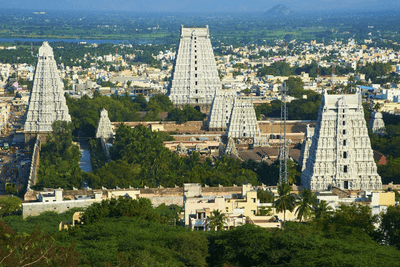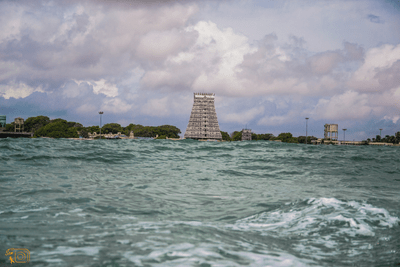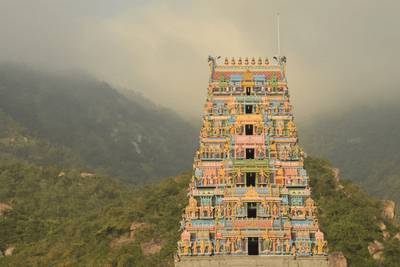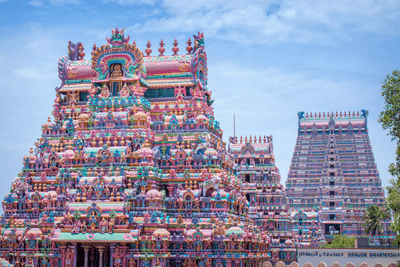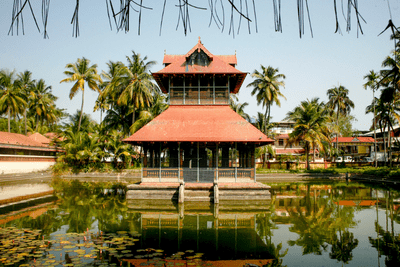Spiritual and Heritage Tours of Tamil Nadu
Duration
20D,19N
Overview
The tourism industry of Tamil Nadu is the largest in India, with an annual growth rate of 16 percent. Tamil Nadu has all segments of Tourist attractions which invite tourists. It has cerulean mountains, silver waterfalls, verdant vegetation, sandy beaches, mammoth monuments, timeless temples, fabulous wildlife, scintillating sculptures and reverberating rural life. It has picturesque spots, continuing heritage, cultural confluence and aesthetic magnificence.
State offers multiple attractions for various segments of tourists. It has more than 40,000temples, 1,076 km coastal line (13% of India’s total coastline), 15 Wildlife Sanctuaries, 5 National Parks, 15 Bird Sanctuaries and 5 Tiger Reserves, 5 UNESCO World Heritage sites, 411 Archaeological Survey of India (ASI) monuments.
Tamil Nadu has more temples than any other state in India. Tamil Nadu is home to more than 40,000 temples and is aptly called “the land of temples”. Many are at least 800 years old and are found scattered all over the state. The rulers of various dynasties constructed these temples over centuries. As per the Tamil Nadu government, there are 38,615 temples. Most of the largest Hindu temples reside here, Studded with complex architecture, a variety of sculptures, and rich inscriptions, the temples remain the very essence of the culture and heritage of Tamil land, with historical records dating back to at least 3,000 years.
According to Ministry of Tourism statistics, 4.68 million foreign (20.1% share of the country)and 333.5 million domestic tourists (23.3% share of the country) visited the state in 2015 making it the most visited state in India for both domestic and foreign tourists. Tamil Nadu attracts a large number of international and domestic tourists every year. In 2019,Tamil Nadu attained the first position in International Tourist Visits and the second position in domestic Tourist Visits. In 2020, Tamil Nadu emerged as the top State for Domestic Tourist Visits, accounting for 23% of the total domestic tourist visits. The total domestic tourist footfall increased from 333 million in 2015 to 495 million in 2019, a Compound Annual Growth Rate of 10%. Tamil Nadu is one of the leading States in India for international tourism occupying the second spot for Foreign Tourist Visits for 2020, accounting for 17.1% of the total foreign tourist visits to India. Total international tourist footfall increased from 5 million in 2015 to 7 million in 2019 at a Compound Annual Growth Rate of 10%.
Welcome to the Land of Culture, Heritage and Temples!
Included/Exclude
- A/c Accommodation on twin sharing basis with Daily Breakfast(Only 1 B/F).
- AC car for all the transfers and local sightseeing as per the given itinerary.
- Well-experienced and bilingual driver till the departure.
- All the expenses related to the vehicle (toll, tax, parking, permits, driver batta, etc).
- Hotel Check-in at 12 pm and check-out at 10 am.
- The driver is only available as per the program given above.
- All the applicable taxes.
- No hidden costs.
- The packages do not include Volvo bus tickets.
- Guide charges, entry fees, Camera Charges, Massages, Elephant Safaris, Personal expenses like laundry, tips and telephone calls, Optional Tours, Travel Insurance, etc.
- Optional activities are mentioned in the itinerary & anything not mentioned in the above package.
- In case of payment made by cr card or debit card service charge of 2.5% and 1% will be charged extra.
Tour Amenities
Tour Plan
- Pazhani (Palani) is dedicated to Lord Dandayutahpani. It is a famous pilgrimage town and every year more than 7 million devotees visit the Temple and offer prayers to Lord Muruga. This temple draws the largest number of devotees in Tamil Nadu.
- Pazhamudircholai's origin dates back several hundred years. Nakkirar, Arunagirinathar and Avvaiyar are among the Tamil saints who have made references to this shrine. Pazhamudircholai is famous for fruits, vegetables and flowers. On a fertile hill with many natural springs and herbs.
- Thirupparam Kundram: This abode of Lord Murugan is noted for its inner sanctum sanctorum that is cut out of a single hard rock. The main temple was a cave shrine earlier. The rest of the structure dates back to the Nayak period.
- Thiruchendur: This temple is 2000 years old. Lord Murugan in this temple is in a different posture, holding a string of Rudraksha beads instead of the usual spear. Tiruchendur means a sacred and prosperous town of victory. There is no other shrine in Tamil Nadu with such a beautiful natural setting. Taking bath in any of the nine teerthams is believed to confer miraculous benefits on the devotee.
- Swamimalai The sacred story associated with this temple is that Lord Karthikeya expounds the meaning of pranavam, AUM to his father, Lord Shiva, at this location. Lord Murugan imparts this universal mantra to his father. Lord Muruga is also known as Swaminathan and “Thagappan Swami” literally “Father God” - referring to the fact that Lord Muruga taught Pranava to his father and hence he was his father's Guru. Swamimalai village has the only school that teaches the art craft of making bronze icons.
- Tiruttani hill temple has 365 steps indicating 365 days of the year. Here, Lord Muruga is in resplendent splendour with his consort Valli, whom he married after bringing her from nearby Vallimalai.
| Planet | Prime Temple | Navagraha Temple Near Chennai |
| Surya (Sun) | Suryanar Koil | Agastheeswaram (Kolapakkam) |
| Chandra (Moon) | Tingaloor Koil | Somanatheeswarar (Somamangalam) |
| Chevaai (Mars) | Vaitheswaran Koil | Vaitheeswaran (Poonamallee) |
| Budhan (Mercury) | Tiruvenkadu | Thirumeyneeswarar (Kovur) |
| Guru (Jupiter) | Alangudi | Ramanadeshwarar (Porur) |
| Shukran (Venus) | Kanchanoor | Velleswarar (Mangadu) |
| Shani (Saturn) | Tirunallar | Agastheeswaram (Pozhichalur) |
| Rahu | Tirunageswaram | Thirunageshwaram (Kundrathur) |
| Ketu | Keezhperumpallam | Neelakanteswarar (Gerugambakkam) |
- Surya Navagrahastalam - Karupulleshwarar temple, Nellore, Gudiyatham
- Chandra Navagrahastalam - Sri Linganatha Swamy temple
- Angaarakan Navagrahastalam - Sri Mahadevar temple
- Budha Navagrahastalam - Sri Semmalai temple
- Guru Navagrahastalam - Sri Gurubhagavan temple, Perumbadi.
- Sukra Navagrahastalam - Sri Kaalabhairavar temple, Pogalur
- Shani Navagrahastalam - Sri Baalasarthuleshwarar temple, Gudiyatham north
- Raahu Navagrahastalam - Sri Naganathaswamy temple, near Gudiyatham
- Ketu Navagrahastalam - Sri Naganathaswamy temple, near Gudiyatham
- Kuchanuraan Temple - Ashtamathu Sani (Saturn), Kuchanur (Theni),
- Saneeswarar Tirukkoil - Sani (Saturn), Tirunaaraiyur -Nachiarkoil (Tanjavur),
- Sri Vasishteswarar Temple -Guru (Jupiter), Thenkudi Thittai (Tanjavur)
- Navapasanam Devipattinam Temple - Navagaragam Nine stone Devipattinam.
| Element | Lingam | Temple | Location |
| Land | Bhumi Lingam | Ekambareswarar Temple | Kanchipuram |
| Water | Varuna Lingam | Jambukeshwarar Temple | Thiruvanaikaval |
| Fire | Agni Lingam | Arunachaleswarar Temple | Thiruvannamalai |
| Air | Vayu | Srikalahasti Temple | Kalahasti |
| Sky | Indra Lingam | Thillai Natarajar Temple | Chidambaram |
- Land - Thanthondreeswarar Temple – Belur
- Water – Sambamoortheeswarar Temple – Ethapur
- Fire – Kaya Nirmaleswarar Temple – Attur
- Air – Kamanda Easwarar Temple – Aragalur
- Sky – Swarnapureeswarar Temple – Koogaiyur
- Kali Tandava at Rathinachabai in Vada Aaranyeswarar Temple, Thiruvalangadu.
- Ananda Tandava at Porchabai in Natarajar Temple, Chidambaram.
- Sandhya Tandava at Vellichabai in Meenakshi Amman Temple, Madurai.
- Muni Tandava at Thamirachabai at Nellaiappar Temple, Tirunelveli.
- Tripura Tandava at Chithirachabai in Kutralanathar Temple. Courtallam.
- Papanasam - Arulmigu Papanasa Nathar Temple - Suriyan
- Cheran Mahadevi - Arulmigu Kailasa Nathar Temple - Chandran
- Kodaganallur - Arulmigu Kailasa Nathar Temple - Chevvai
- Kunnathur - Arulmigu Kotha Parameswarar Temple - Raghu
- Murappanadu -Arulmigu Kailasa Nathar Temple - Guru
- Thiruvaikundam - Arulmigu Kailasa Nathar Temple - Sani
- Thenthirupperai - Arulmigu Kailasa Nathar Temple -Buthan
- Raajapathy - Arulmigu Kailasa Nathar Temple - Kethu
- Saendha Poomangalam, Tuticorin - Arulmigu Kailasa Nathar Temple – Sukran
- Srivaikuntanathan Permual Temple – Sun - Srivaikuntam
- Vijayaasana Perumal Temple - Moon - Natham
- Vaithamanidhi Perumal Temple - Mars - Thirukolur
- ThiruPulingudi Perumal Temple – Mercury - Thirupulingud
- AlwarThirunagari Temple - Jupiter - Alwar Thirunagari
- Makara Nedunkuzhai Kannan Temple – Venus - Thenthiruperai
- Srinivasa Perumal Temple, Tirukulandhai – Saturn - Thirukulandhai
- Irattai Thiruppathy, Aravindalochanar temple – Rahu - Tholavillimangalam
- Veerateeswarar temple, Thirukovilur, Tiruvannamalai district
- Veerateeswarar temple, Thiruvathiga, Cuddalore
- Veerateeswarar temple, Korukkai, Mayiladuthurai district
- Kandeeswarar Temple, Thiru Kandiyur, Thanjavur district
- Amritaghateswarar-Abirami Temple, Thirukkadaiyur, Mayiladuthurai district
- Veerateeswarar temple, Thirupariyalur, Mayiladuthurai district
- Veerateeswarar temple, Vazhuvur, Mayiladuthurai district
- Veerateeswarar temple, Thiruvirkudi, Mayiladuthurai district
- Aiyarappar temple, Thiruvaiyaru
- Apathsahayar Temple, Tirupazhanam
- Odhanavaneswarar Temple, Tiruchotruthurai
- Vedapuriswarar Temple, Thiruvedhikudi
- Kandeeswarar Temple, Thirukkandiyur
- Puvananathar Temple, Thirupanturuthi
- Neyyadiappar Temple, Tiruneithaanam
- Thyagarajar Temple, Tiruvarur – Vidhividangar - Ajaba Natanam
- Dharbaranyeswarar Temple, Tirunallar – Nagaravidangar - Unmatha natanam
- Kayarohanaswamy Temple, Nagapattinam - Sundaravidangar – Vilathi natanam
- Kannayariamudayar Temple, Thirukarayil - Adhividangar - Kukuda natanam
- Brahmapureeswarar Temple, Thirukkuvalai - Avanividangar - Brunga natanam
- Vaimoornaathar Temple, Tiruvaimur – Nallavidangar - Kamala natanam
- Vedaranyeswarar Temple, Vedaranyam - Bhuvanivividangar - Hamsapatha natanam
- Chakravageshwarar Temple - Chakramangai, Chakkarapalli, Thanjavur
- Arimutheeswarar Temple – Harimangai, Ariyamangai, Thanjavur
- Krithivageswarar temple – Soolamangai, Soolamangalam, Thanjavur
- Jambugeswarar Temple – Nandimangai, Tirupullamangai, Thanjavur
- Pasumangai Temple - Pasumangai, Thirukkandiyur, Thanjavur
- Chandramouleeswarar Temple – Thazhamangai, Thazhamangai, Thanjavur
- Tirupullamangai Temple – Pullamangai, Pullamangai, Thanjavur
- Ajna - Brain directly behind eyebrow - Natarajar Temple, Chidambaram
- Visuthi - Neck region near spine - Sri Kalahastheeswara Swami Temple, Kalahasthi
- Anahata - Central channel behind spine - Kashi Vishwanath Temple, Varanasi
- Manipooragam - Spine directly behind the navel- Arunachaleshwarar Temple, Thiruvannamalai
- Swathistanam - One's own abode – Thiruvanaikaval, Trichy
- Moolatharam - Basal end of the spinal - Thyagaraja Swamy Temple, Tiruvarur
- Brihadeeshwarar Temple at Thanjavur
- Airavatheeswara Temple at Darasuram
- Gangaikonda Cholapuram Brihadeeshwarar Temple at Jayankondam
- Group of Monuments at Mahabalipuram
- Nilgiri Mountain Railway
-
-
- Ashwini - Tiruthuraipoondi Piravi Maundeeswarar temple
- Bharani - Nalladai Agneeswarar temple
- Karthigai - Kanjanagaram Kathra Sundareswarar temple
- Rohini - Kancheepuram Sri Pandava Dhoodha Perumal temple
- Mirugasesam - Enkan Aadhinarayanaperumal temple
- Thiruvathirai - Athirampattinam Sri Abhaya Varadeeswarar Temple
- Bunarpoosam - Vaniambadi Athitheeswarar temple
- Poosam - Vilankulam Akshayapureeswarar temple
- Ayilyam - Tirundhuthevankudi Karkadeswarar temple
- Maham - Medai Mahalingeswarar temple
- Pooram - Tiruvarankulam Hari Theertheswarar temple
- Uthiram - Idayattru Mangalam Mangalyeswarar temple
- Astham - Komal Kirubakubareshwarar temple
- Chithirai - Kuruvithurai Chitraradha Vallaba Perumal temple
- Swathi - Chithukadu Thatheeswarar temple
- Visakam - Panmozhi Muthukumaraswami temple
- Anusam - Tirunindriyur Mahalakshmiswarar temple
- Ketai - Pasupathikovil Varadarajaperumal temple
- Moolam - Mappedu Singeeswarar temple,
- Pooradam - Kaduveli Akashapureeswarar temple
- Uthiradam - Keezha Poongudi Brahmmapureeswarar temple
- Thiruvonam - Tiruparkadal Prasanna Venkateswara Perumal temple
- Avitam - Keezha Korukkai Brahammagnana Pureeswarar temple
- Sathayam - Tirupugalur Agnipureeswarar temple
- Pooradathi - Ranganathapuram Tiruvaneshwar temple
- Uthiradathi - Theeyatur Sahasra Lakshmeeswarar temple
- Revathi - Karukudi Kailasanathar temple
-
- Kanchipuram district
- Pudukkottai district
| Karandai Digambar Jain Temple complex Kumbakonam Jain Temple Poondi Arugar Temple, Arani Thirakoil Hill and the Digambara Jain Temple Trilokyanatha Temple Mallinathaswamy Jain Temple, Mannargudi Mel Sithamur Jain Math Andimalai Jain Caves, Cholapandiyapuram Deepanayakaswamy Jain Temple Ennayira Malai (Ancient Jain cave, beds and inscriptions), Ennayiram Jambaimalai caves, Jambai Kalugumalai Jain Beds Adukkankal Jain Beds, Nehanurpatti Kurathimalai, Koosamalai Beds – Onampakkam Vallimalai Jain caves Vijayamangalam Jain temple Keezh Villivanam, Thiruvannamalai Dt. Keezh Edayalam, Villupuram Dt. Kilsathamangalam, Thiruvannamalai Dt. Koliyanur, Villupuram Dt Kolathur, Chennai Dt. Kovilampoondi, Thiruvannamalai Dt Kumbakonam, Thanjavur Dt. Mannargudi Mallinatha Swamy Jain Temple, Nagapattinam Dt. Melapandal, Vellore Dt. Melmalaiyanur, Villupuram Dt. Mel Sithamur Jain Math, Villupuram Dt. Mettu Street, Kanchipuram Mudalur, Thiruvannamalai Dt. Nallavanpalayam, Thiruvannamalai Dt Nallur, Thiruvannamalai Dt. Nanganallur, Chennai Dt. Naval, Thiruvannamalai Dt. Nedimolliyanur Villupuram Dt. Nelliyankulam, Thiruvannamalai Dt. Othalavaadi, Thiruvannamalai Dt. Parshwa Padmavathi Jain Temple, Sundampatti, Orappam Krishnagiri Dt. Pammal, Chennai Peranamallur, Thiruvannamalai Dt Perani, Villupuram Dt. Peravoor, Villupuram Dt. Periyakozhappalur, Thiruvannamalai Dt. Perumandur, Villupuram Dt. Perumbogai, Thiruvannamalai Dt. Poondi Arugar Temple, Ponnur Malai, Thiruvannamalai Dt. Puzhal, Chennai Dt Renderipet, Thiruvannamalai Dt. R.Kunnathur, Thiruvannamalai Dt. Shri Vasupujya Temple, Sathuvachari, Vellore Sathuvachari, Vellore Dt. Sevur, Vellore Dt. Thondur, Villupuram Dt Tindivanam, Villupuram Dt Tirumalai, Polur Dt Trilokyanatha Temple, Kanchipuram Dt Valathi / Valathy, Villupuram Dt. Vandavasi, Thiruvannamalai Dt. Valapandal Vellore Dt. Veedur, Villupuram Dt. Veeranamur, Villupuram Dt. | Aadhinath Jain Temple, Cuddalore (old) Anumanthakudi, Sivagangai dt Adambakkam, Adi Nath Digambar Jain Temple Chennai Agalur, Villupuram Dt. Agarakorakottai, Thiruvannamalai Dt. Alagramam Jain Temple, Villupuram Dt. Arahanthgiri Jain Math, Thiruvannamalai Dt. Arani (S.V.Nagaram), Thiruvannamalai Dt. Arani (Pudukamur), Thiruvannamalai Dt. Arani (Saidapet), Thiruvannamalai Dt. Arani (Palayam), Thiruvannamalai Dt. Arani (Kosapalayam) Thiruvannamalai Dt. Arani (sevoor) Thiruvannamalai Arungulam Kanchipuram Dt. Arpaakkam, Kanchipuram Dt. Arugavur, Solai, Thiruvannamalai Dt. Avadi, Chennai Dt Ayalavadi, Thiruvannamalai Dt Chitharal Jain Temple: 9th-century temple Chitharal malai kovil: Before 425 CE Cheyyar, Thiruvannamalai Dt. Deepangudi, Nagapattinam Dt Easaakolathur, Thiruvannamalai Dt Elangadu, Thiruvannamalai Dt. Adisvaraswamy Jain Temple, Thanjavur Eyyil, Villupuram Dt. Erumbur, Thiruvannamalai Dt George Town, Chennai Dt. Gingee, Viluppuram Dt. Ilayangudi, Sivagangai Dt. Kannalam, Villupuram Dt. Kallapuliyur, Villupuram Dt. Kallakullathur, Villupuram Dt. Karanthai, Kanchipuram Dt. Karanthai Jain Temple, Thanjavur Dt. Kalugumalai Jain Beds Dt. Kanchiyur Jain cave and stone beds Dt Kattumalaiyanur, Thiruvannamalai Dt. Sitharaal, Nagercoil Dt. Sittanavasal, Pudukottai Dt. Sitthamur, Villupuram Dt. (Oldest Jain temple and Jain math) Somaasipadi, Thiruvannamalai Thellar, thiruvannamalaiDt. Thirunarunkundram, Villupuram Dt. Thiruparuthikundram temple, Kanchipuram Dt. Thirupanamoor, Thiruvannamalai Dt. near Kanchipuram Thachambadi, Thiruvannamalai Dt. Thatchur, Thiruvannamalai Dt. Thayanur, Villupuram Dt. Thennathur, Thiruvannamalai Dt Thirakoil, Thiruvannamalai Dt Thirupparankunram, Madurai Dt.(Sangam literature Paripadal 19 step 51) Thiruvannamalai, Thiruvannamalai Dt. Vellimedupettai, Villupuram Dt Vempoondi, Villupuram Dt. Venbakkam, Kanchipuram Dt. Vilangadupakkam, Chennai Dt. Vizhukkam, Villupuram Dt. Vijayamangalam, Erode Dt. Virudur, Thiruvannamalai Dt. Nasiyan Jain Temple,Prithvi Raj Road,ooty,dedicated to Rishabhdevji. Sri 1008 Vaupujya Swamy Swethambar Jain Temple, Ooty |
- Agastiyar - Adi Kumbeswarar Temple, Kumbakonam
- Thirumoolar - Komuteeswara Temple in Thiruvaduthurai
- Sivavakkiyar / Nandi Devar - Masilamaneeswarar temple in Thiruvaduthurai
- Bhogar / Boganathar - Arulmigu Dhandayuthapaniswamy Temple, Palani
- Vamadevar / (Vanmeegar) Valmiki - Ettukudi Murugan Temple in Nagapattinam
- Idaikadar - Arunachala temple, Thiruvannamalai
- Sattamuni - Thiruvedagam, west Madurai & in the Ranganathaswamy Temple
- Kamalamuni / Kamala munivar - Thiyagarajar temple, Thiruvarur
- Machamuni - Kasi Vishwanathar temple, Tiruparankundram hill, Madurai
- Konganar - Gomuteeswarar Temple, Thiruvavaduthurai,
- Pathanjali - Brahmapureeswarar Temple - Thirupattur Trichy
- Pambatti - Sankaran Koil near Puliyankudi behind Gomathi Amman
- Sundaranathar - Meenakshi Amman temple, Madurai
- Kuthambai - Periya Koyil, Mayiladuthurai (Mayavaram),
- Karuvoorar - On the southern side of Sri Kalyana Pasupatheeswarar temple, Karur
- Goraknath / Korakkar - Shiva temple, north Poigainallur (near Nagapattinam)
- Thanvanthri - Vaitheeswaran Temple, west Pullirukkuvelur
- Ramadevar (Yakub siddhar) Alagar malai (near Pazhamuthircholai Murugan Temple)
- Agapaei (Nayanaar) Siddhar - Yettakudi
- Kumbamuni (another name for Agastiyar) - Kutandhai (Kumbakonam)
- Pulathiyar - Papanasam
- THE BASILICA OF OUR LADY OF GOOD HEALTH, VELANKANNI
- SAN THOME CATHEDRAL BASILICA, CHENNAI
- ST. MARY'S CATHEDRAL CHURCH, MADURAI
- OUR LADY OF RANSOM CHURCH, KANYAKUMARI
- LA SALETH CHURCH, KODAIKANAL
- OUR LADY OF SNOWS BASILICA, TUTICORIN
- HOLY TRINITY CHURCH, OOTY
- KARAMALAI ANNAI VELANKANNI CHURCH, VALPARAI
- KAPPAL MATHA CHURCH, TIRUNELVELI
- HOLY TRINITY CHURCH, YERCAUD
- ARMENIAN CHURCH, CHENNAI
- CHRIST THE KING CHURCH, KODAIKANAL
- Athar Jamad Mosque
- Bawa Kassim Valiyullah Mosque
- Begumpur Mosque, Dindigul
- Butt Road Jumma Masjid
- Goripalayam Mosque
- Jama Mosque, Kanchipuram
- Kattubava Mosque
- Khutba Periya Palli, Kayalpattinam
- Kottaimedu Mosque, Coimbatore
- Madurai Maqbara
- Malik ibn Dinar Mosque
- Masjid-e-Anwari
- Meltheru and Keeltheru Mosques
- Mohaideen Andavar Mosque
- Muhyiddin Andavar Mosque
- Nadir Shah Mosque
- Nagore Dargah
- Nawab Jamia Mosque
- Palaiya Jumma Palli
- Sungam Mosque
- Thiruparankundram Dargah
Duration
20D,19N


